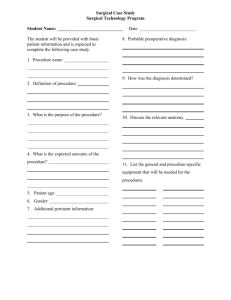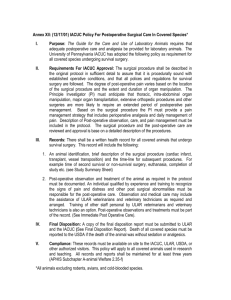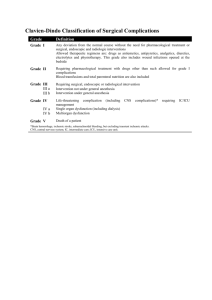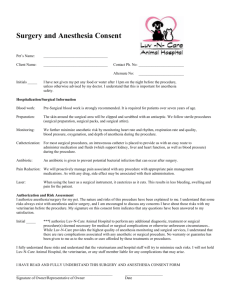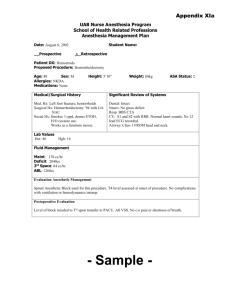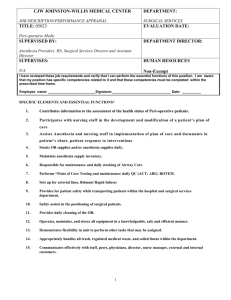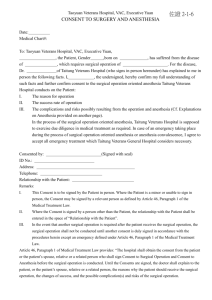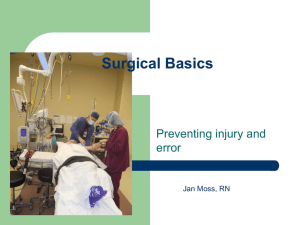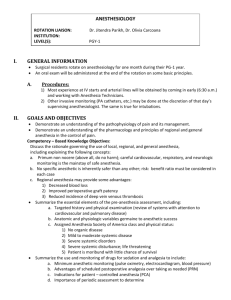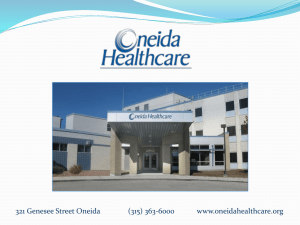Postoperative Recovery Record for Animal Monitoring
advertisement
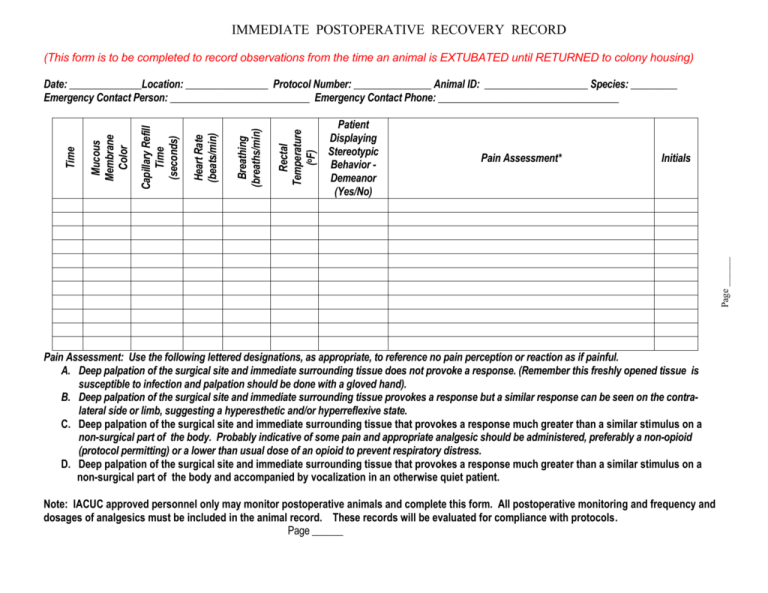
IMMEDIATE POSTOPERATIVE RECOVERY RECORD (This form is to be completed to record observations from the time an animal is EXTUBATED until RETURNED to colony housing) Patient Displaying Stereotypic Behavior Demeanor (Yes/No) Pain Assessment* Initials Page ______ Rectal Temperature (oF) Breathing (breaths/min) Heart Rate (beats/min) Capillary Refill Time (seconds) Mucous Membrane Color Time Date: ______________Location: ________________ Protocol Number: _______________ Animal ID: ____________________ Species: _________ Emergency Contact Person: ___________________________ Emergency Contact Phone: ___________________________________ Pain Assessment: Use the following lettered designations, as appropriate, to reference no pain perception or reaction as if painful. A. Deep palpation of the surgical site and immediate surrounding tissue does not provoke a response. (Remember this freshly opened tissue is susceptible to infection and palpation should be done with a gloved hand). B. Deep palpation of the surgical site and immediate surrounding tissue provokes a response but a similar response can be seen on the contralateral side or limb, suggesting a hyperesthetic and/or hyperreflexive state. C. Deep palpation of the surgical site and immediate surrounding tissue that provokes a response much greater than a similar stimulus on a non-surgical part of the body. Probably indicative of some pain and appropriate analgesic should be administered, preferably a non-opioid (protocol permitting) or a lower than usual dose of an opioid to prevent respiratory distress. D. Deep palpation of the surgical site and immediate surrounding tissue that provokes a response much greater than a similar stimulus on a non-surgical part of the body and accompanied by vocalization in an otherwise quiet patient. Note: IACUC approved personnel only may monitor postoperative animals and complete this form. All postoperative monitoring and frequency and dosages of analgesics must be included in the animal record. These records will be evaluated for compliance with protocols. Page ______ Analgesic Tim Medication: Dose, Route e Initial Other Medications: Time Medication: Dose, Route Initial Notes Initial Page ___________ This Form has been developed with the understanding that the time from extubation to an animal's return to the Intensive Care Unit or colony housing rarely comprises a period in excess of 45 minutes to 1.5 hours. 1. Recovery from anesthesia is in the reverse of induction. Because induction is drug induced and rapid, the excitatory phase of induction is not seen but will be much in evidence during recovery. This will include involuntary thrashing and movements; apparent aggressive behavior; involuntary voiding and defecating; vocalizing; ataxia and muscle incoordination; hyperreflexia and exaggerated response to tactile stimuli that would not normally cause a response. These are not signs indicative of pain but of imbalance in the central and peripheral nervous system coordination. If appropriate preemptive analgesics have been given preoperatively and/or interoperatively, one must be very cautious about assuming “unusual” actions to have their origins in pain. 2. Since the animal has just experienced surgery and intravenous fluid administration, hydration status would most appropriately be addressed several hours after the animal has returned to the colony or is settled in intensive care. 3. There is usually some involuntary release of urine from the bladder during this excitatory phase and may also include defecation. This is not an indication of pain or a certain stage of recovery. 4. Under anesthesia, particularly if a thoracotomy has been performed, lung tissue has been compressed and there is a redistribution of blood flow in the uncompromised lung. This ventilation/perfusion (V/Q) ratio becomes unstable during the recovery phase and animals will often increase the respiratory rate as part of the excitatory phase of recovery; as an attempt to oxygenate when the V/Q is not physiologic; as an attempt to breath in an unusual position with abdominal viscera compressing the diaphragm. Not to be confused with pain. 5. Some of our surgical patients (sheep, rabbits, guinea pigs, pigs) have essentially one defense mechanism…movement away from perceived trouble. Recovery from anesthesia sets defense mechanisms into play for these species. Not to be confused with pain 6. Some of our surgical patients (dogs, cats, non-human primates, rats, mice, birds) use their biting instincts as a defense mechanism against the unknown and may do this during the recovery phase of anesthesia. Not to be confused with pain 7. Recovery from anesthesia where a barbiturate, pentobarbital or pentothal, has been used for induction often produces paddeling and head shaking/banging against the surgical table or floor when being recovered. Not to be confused with pain.
